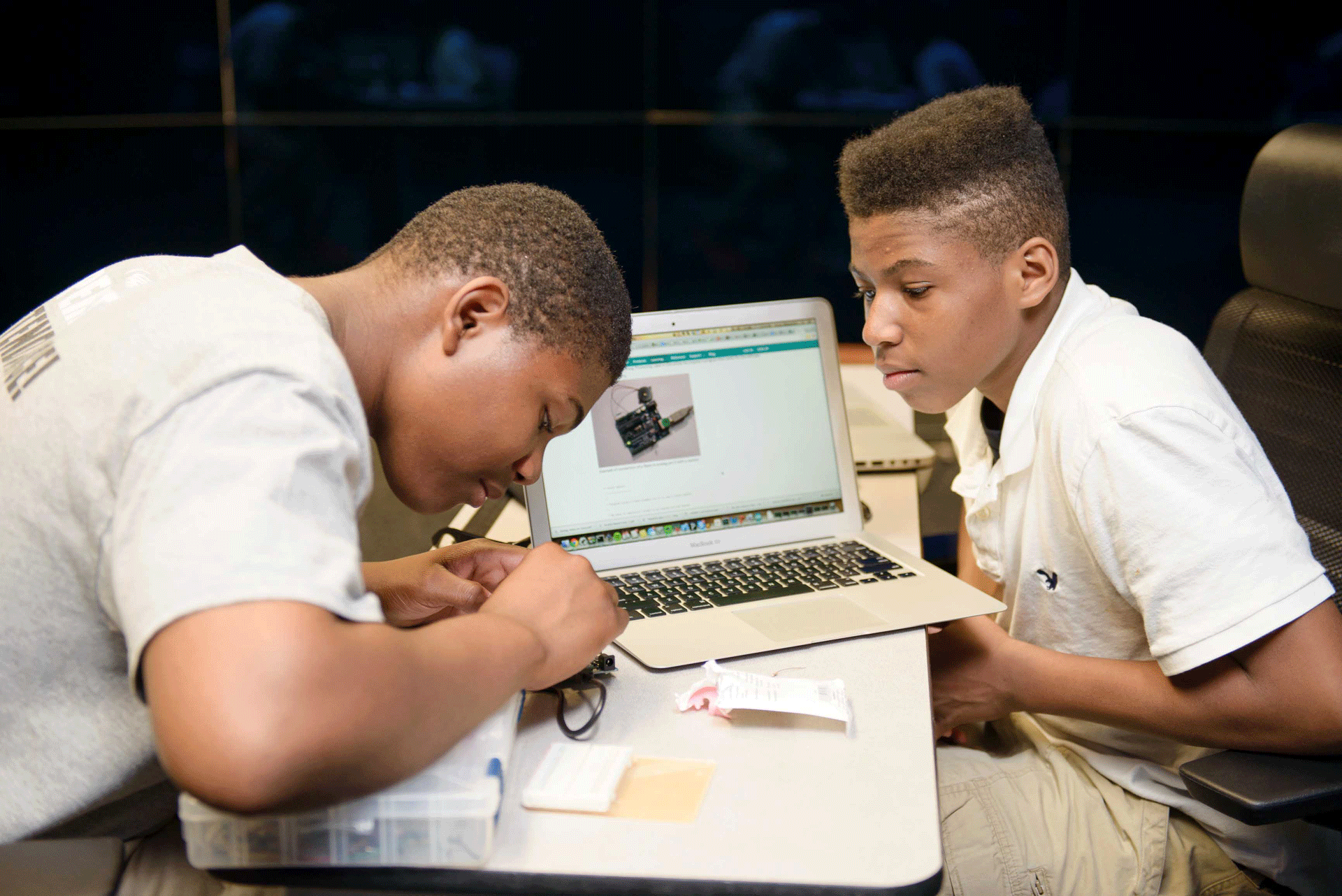Pushing the Limits of Technology While Giving Back to the Community Through Mentorship
June 18th, 2014
Categories: Applications, Education, Multimedia

About
Spark Chicago motivates and nurtures underserved youth through after-school mentorship and volunteer programs. And so it happened that two middle-school boys, one who wants to design video games and one who wants to be a chef, became apprentices at the Electronic Visualization Laboratory (EVL) at the University of Illinois at Chicago (UIC) during Spring 2014 semester, and worked on a virtual-reality video-game project one afternoon a week for 10 weeks.
UIC Computer Science PhD students and EVL research assistants Victor Mateevitsi and Alessandro Febretti volunteered as mentors to Dexter Wells and Glen Poole from Legacy Charter School, and the team created a unique slingshot game combining a tangible computer-controlled slingshot with virtual-reality targets on the walls of the CAVE2™ environment.
The idea for the slingshot game came out of team discussions, followed by the development of a storyboard for the game. The only requirement was that the game use a new input device, which Wells and Poole were expected to build. A real slingshot with pellets would break the walls of CAVE2, so a computer-based slingshot had to be designed from scratch.
Mateevitsi and Febretti had wanted more computer-based input devices for the CAVE2, like a button or slider, to provide applications with new ways to interact with their data, besides the current video-game controller. Rather than build themselves, they developed the schematics and let Wells and Poole build it. “They were very creative, very excited, and seemed to compete to see who could first work on the controller or fix something,” observed Mateevitsi, “and, they were both interested in coding and programming, so were engaged in all aspects of this project.”
The slingshot was entirely improvised. The projectile was virtual (a red ball on the walls of the CAVE2). The elastic material was a regular rubber band. And, instead of a Y-shaped slingshot frame, they used the post on the back of a chair that held up a headrest; the chair was on wheels so could easily be moved and repositioned in the CAVE2. The students put the rubber band around the back of the post, stretched, and released. To make this game work properly, however, the CAVE2 application had to know which way the chair was facing, how far back the user’s hand was stretching the elastic band (so the physics of the projectile’s movement could be calculated), and when the virtual red ball was released.
To provide this information, the team used unique patterns of infrared reflective markers on the headrest of the chair and on a glove on the user’s hand, enabling the CAVE2 tracking system to locate the unique objects in the environment. A pressure sensor - interfaced to an Arduino electronics micro-controller board - was placed on the back of the headrest post of the chair. When the rubber band was physically released and touched it, the Arduino sent instructions via wireless networking to the CAVE2 software that the rubber band was released and the virtual red ball was flying towards its target.
Each week, when setting up the game, Febretti had to reapply the infrared reflective markers and reprogram the CAVE2 software to recognize the unique patterns. “Once I forgot to do this,” said Febretti, “and Wells and Poole quickly corrected me! They were very attentive during the entire project.” What about the game itself? The virtual target was a wall of stacked boxes. The middle column of boxes was a different color, and the user was expected to shoot all the boxes except for the ones in the middle column.
In early June, at the end of the 10-week apprenticeship, Spark Chicago sponsored Discovery Night, so the students could share their experiences and their projects with family and friends. Mateevitsi and Febretti ported the slingshot game to a laptop computer. Users controlled the mouse to move the slingshot left and right, and pushed the pressure sensor button to release the virtual ball. Attendees all enjoyed playing it, and the EVL mentors were very proud of their young apprentices.
“And best yet,” says Mateevitsi, “their creativity and innovation has given EVL an Arduino controller interface to CAVE2, which can take input from various sensors, and be used to prototype new tactile interfaces for virtual-reality applications. Being a part of programs like Spark allows my research to push the limits of technology while still giving back to the community through mentorship.”
Mateevitsi and Febretti, with UIC Art undergraduate and EVL research assistant Uthman Shabazz, produced a humorous video to describe the project.
This is the second year that Mateevitsi and Febretti volunteered for Spark Chicago, and the third year that EVL has participated in the program.
To learn about EVL’s past efforts, see:
2013: Middle-school kids create a virtual future in 3-D
2012: Spark Student Mentored in Video Game Development at the UIC Electronic Visualization Laboratory